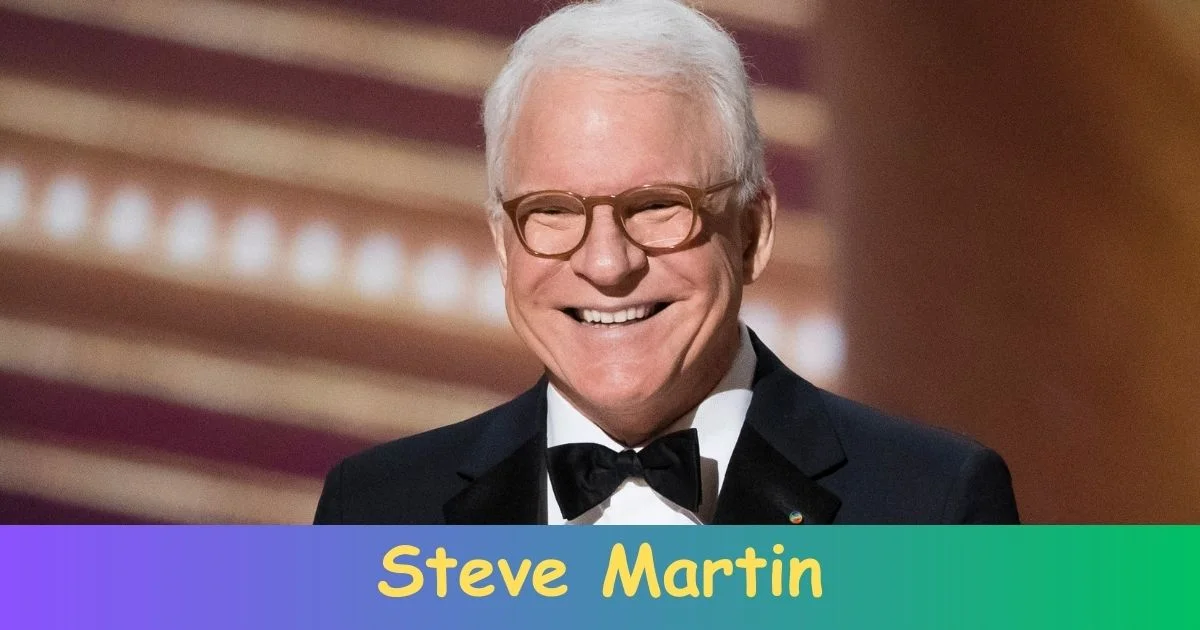Why Do People Love Steve Martin?
Steve Martin is one of the most beloved comedic actors and writers of the last 50 years. His unique brand of intellectual slapstick comedy has entertained audiences across multiple generations.
Martin first broke through as a standup comic in the 1970s, achieving massive success. He then transferred his comedic talents over to movies, starring in classic comedy films spanning from the late 1970s through the 2000s.
Martin has managed to maintain popularity over such a long career through his willingness to take risks and evolve with the times. He’s balanced broader mainstream comedy films with more nuanced dramatic roles in his later years.
Through it all, Martin always comes across as both clever and approachable. These qualities, along with his undeniable talent, help explain why he remains so admired until today.
What Made Steve Martin Stand Out as a Young Comedian?
When Steve Martin started doing standup comedy in the early 1970s, he brought a unique style and perspective that stood out from other performers of the era.
“Wild and Crazy Guy” Persona Was a Hit
Martin created an offbeat stage persona as a loud, foolish, nerdy man in a white suit who enthusiastically embraced nonsense. This “Wild and Crazy Guy” character connected with younger audiences tired of status quo comedy. It balanced rebellious silliness with an underlying intellectualism.
Mixed Absurdity and Intelligence
While he played up a buffoon-like persona on stage, Martin always maintained an astute self-awareness. His comedy balanced broad, absurd premises with incisive social commentary. This displayed his intelligence even as he played the fool.
Modernized Standup With Sketch and Music
Martin broke boundaries by incorporating sketches, props, music numbers, and multitasking characters into his act. This expanded the definition of standup, setting the stage for comics to utilize more creative freedom.
Aspects of Steve Martin’s 1970s Comedy Style
| Comedy Style Attributes | |-|-|
| Wild and Crazy Guy persona | | Balancing absurdity and commentary |
| Multifaceted performances |
How Did Steve Martin Translate His Comedy to Movies?
When Steve Martin moved into film comedy in the late 1970s, he brought the same innovative spirit and willingness to court controversy.
Starred in Modern Comedy Classics
Martin starred in several of the most acclaimed and successful comedy films of all time over a relatively short period, including The Jerk (1979), Dead Men Don’t Wear Plaid (1982), Three Amigos! (1986), Roxanne (1987), Planes, Trains and Automobiles (1987), Parenthood (1989) and Father of the Bride (1991).
Often Played Similar Personas From Standup
While expanding his range, Martin frequently played versions of his snarky yet foolhardy standup persona on the big screen. This consistency helped solidify his brand and build a loyal fanbase.
Teamed With Other Talented Comedians
Many Steve Martin classics feature him sharing the screen with other acclaimed comedy performers. Teaming up with stars like John Candy, Chevy Chase, Martin Short, Rick Moranis, and Eddie Murphy elevated the hilarity.
Notable Steve Martin Comedy Film Collaborators
| Name | Films Together |
|---|---|
| Chevy Chase | Three Amigos!, Planes, Trains & Automobiles |
| John Candy | Planes, Trains & Automobiles |
| Martin Short | Three Amigos!, Father of the Bride |
| Rick Moranis | My Blue Heaven, Parenthood |
How Has Steve Martin Evolved as a Performer?
While his early work stuck closely to his wacky standup persona, Steve Martin has shown impressive evolution as both a comedic and dramatic actor in recent decades.
Has Excelled in Family Films
In addition to the two Father of the Bride movies, Martin has thrived in several sophisticated family comedies like Cheaper by the Dozen (2003) and Bringing Down the House (2003). He injects heart and wisdom into these performances.
Has Revealed His Dramatic Abilities
Martin earned critical acclaim for his work in dramas including Grand Canyon (1991), Shopgirl (2005), and The Spanish Prisoner (1997). These prove him to be more than just a comedian.
Found the Perfect Vehicle in his Later Years
The role of Inspector Jacques Clouseau in The Pink Panther (2006) and sequel seemed tailor made to take advantage of Martin’s talents. As the bumbling investigator, he’s allowed to showcase both masterful physical comedy and drier, cerebral wit.
Table 3: Steve Martin Drama Performances Demonstrating Range
| Dramatic Film Role | Year Released |
|---|---|
| Gravedigger in The Spanish Prisoner | 1997 |
| Architect in Grand Canyon | 1991 |
| Shop owner in Shopgirl | 2005 |
Why Do Audiences Feel Connected to Steve Martin?
Steve Martin has cultivated a persona that, while undeniably quirky, also comes across as accessible and relatable. This likability helps explain the depth of his popularity.
Persona is Unique But Approachable
With his poor fashion sense and general lack of coolness, audiences don’t feel intimidated or distanced from Martin. He comes across as an eccentric everyman.
Rebellious Spirit
Throughout his career Martin has thrived on bucking convention and embracing the unconventional. Fans admire his willingness to take creative risks and go against the grain.
Multi-Talented
Beyond acting, Martin is an acclaimed writer, producer, musician, playwright and novelist. Audiences admire and feel connected to such a virtuosic performer.
Maintains a Low-Key Presence
Despite his fame, Martin keeps a relatively low public profile focused on his work rather than flashy lifestyle. This modesty makes him more relatable.
Conclusion
Steve Martin has inhabited an unparalleled position in American comedy over the past 50 years through the perfection of his “Wild and Crazy Guy” persona that so utterly charmed audiences. While on the surface playing buffoons with apparent glee, Martin balanced that absurdity with intelligence and even wisdom.
As he transitioned to movies, Martin revealed incredible range in both comedic and dramatic roles. No part ever felt beyond his capabilities. In his later years he has found roles like Jacques Clouseau that perfectly match his considerable physical and verbal talents.
Yet, with all the professional success Martin has achieved spanning eras and mediums, he retains an everyman appeal stemming from his unconventional persona and creative courage. Audiences will likely feel connected to Steve Martin for decades to come thanks to his one-of-a-kind talents and sensibilities.
No matter the role, he always maintains a subtle wink that lets fans know that he too is amused by the various shams, shenanigans and logic-defying schemes in which his characters become embroiled.
Steve Martin invites everyone to share in the joke, while recognizing that it is his special talent to guide us through these silly situations in singular fashion.
Frequently Asked Questions
What was Steve Martin’s big breakthrough?
Steve Martin first achieved major fame from his standup comedy act that he toured extensively in the mid-1970s. His outrageous, irony-laced persona as “The Wild and Crazy Guy” connected with young audiences and paved the way for numerous TV appearances.
Why did Steve Martin move away from standup comedy?
By the end of the 1970s, Martin had achieved such success in standup that he wanted to challenge himself in different creative directions.
He shifted his focus to making movies, wrote pieces for The New Yorker, authored plays like Picasso at the Lapin Agile, pursued music and gradually tapered off standup performances.
What is Martin’s most beloved movie?
Planes, Trains and Automobiles (1987) in which Martin is forced into an unlikely pairing with John Candy trying desperately to get home for Thanksgiving, is considered his most definitive and beloved film.
It showcases Martin’s impeccable timing and ability to wring immense laughs out of awkwardness and discomfort.
Why did Martin take more serious roles later in his career?
Having excelled at comedy, Martin wanted to prove his versatility and avoid career stagnation.
Taking more nuanced dramatic roles expanded his range and opened him up to richer opportunities. Films like Grand Canyon (1991) and Shopgirl (2005) displayed previously unseen emotional depth.
How was Steve Martin involved in Disney theme parks?
Martin collaborated with Walt Disney Imagineering starting in the mid-2000s to help develop Magic Camp, an interactive street theater experience at Disney California Adventure Park involving aspiring young magicians.





